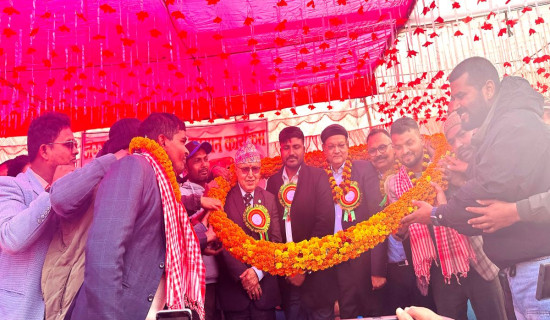- Friday, 26 December 2025
Curb Rising Gold Smuggling
Despite ‘tightened security surveillance’ in place at the Tribhuvan International Airport (TIA), gold smuggling has continued unabated, hurting Nepal’s international repute. This has made TIA as a transit for trafficking of the precious metal. Around 14-kg gold was seized from a person at TIA on Thursday night. Such a large amount of gold was confiscated following the seizure of 60 kg from the same airport in less than five months. A special team deployed at the airport arrested the person immediately upon his arrival from Dubai. Based on a clue, the security team was set to bring the person under control. He came to Kathmandu on a Flydubai flight. The person is Chandra Ghale from Gorkha district. He was found concealing the contraband in his jacket.
Incentives
On the basis of the information, given by Chandra, the police nabbed another individual Min Bahadur Ghale from outside the customs area, Min Bahadur also hails from Gorkha. Initial investigations, conducted by a probe panel. have shown that Chandra was working just as a ‘carrier’ while Min Bahadur was assigned to supply the contraband in the market. The two were offered certain monetary incentives for the duty performed. No mastermind and/or owner of the gold has so far been identified like in most previous gold smuggling incidences. This is a crux of the problem with gold trafficking. Smugglers appear to have been giving continuity to their ‘business’ by changing the forms of smuggling to evade customs officials and security personnel.
Chandra is reported to have planned to leave his jacket with gold in a dustbin at the arrival lounge of the airport and get a sweeper working there to take it out of the airport without having the gold gone through the customs check. Equipped with modern surveillance machines, the customs area at TIA can detect even small coins. But interestingly, kilos of gold have gone undetected for many a time there, creating a lot of doubt about the involvement of customs and security personnel in such an illegal activity. However, the probe panel has now been investigating the matter, focusing on identifying the main culprits involved in this crime.
On Friday morning, three persons were arrested with two kg of gold from Nagdhunga of Kathmandu. They were found hiding the contraband in the gearbox of a jeep they were travelling in. They are suspected to have smuggled gold from Kerung through the Rasuwagadhi border point. Two and a half months ago, 11 kg gold had been seized from Dolakha. Two Chinese nationals were involved in the smuggling. As many as 15 persons have been arrested in this connection. The racket is believed to have been trafficking gold into Nepal through the Phalek entrance located in the northern belt of Dolakha district. As per a police investigation, the same gang had smuggled some 33 kg of gold within a year.
In July, the Department of Revenue Investigation (DRI) sized about 60 kg gold from the airport premises. In the beginning, the DRI began investigations into the matter. Considering the gold trafficking was linked to international racket, the government had assigned the Central Investigation Bureau (CIB) of the Nepal Police to probe the case later. The case has now been under consideration at the Kathmandu District Court. The CIB had urged the Kathmandu District Attorney Office to indict as many as 29 persons, including some foreigners, in this connection. The gold had been smuggled from Hong Kong by hiding it in scooters’ break shoe.
The above incidents indicate that gold smuggling has been rampant in the country. The smugglers seem to have strong international network. Finding security lapses in Nepal, they are found making the TIA a major hub for smuggling the yellow metal. The contraband is mostly smuggled to India from Nepal. The racket was also found operating a machine used for melting gold in Kathmandu. According to the police officials involved in the process of investigation, the gang was seen mobilising individuals to refine gold before selling it in Nepali and Indian markets.
Police reports indicate that gold smuggling has been on the rise considerably over the years. In 2021-22, about 31 kg of gold was smuggled into the country while the quantity increased to 102 kg in 2022-23. Over the past five years, a lot of gold has entered the nation through illegal channels. TIA has witnessed nearly 85 per cent of the total unlawful imports. One of the major reasons for increasing gold smuggling into Nepal is political protection given to smugglers. This fosters a state of impunity that is responsible for such a shameful situation.
Nefarious nexus
In the course of investigation, police had found Chinese national Daojin Wang’s nefarious nexus with top-level Nepali politicians, including the vice-chair of the CPN-Maoist Centre Krishna Bahadur Mahara. Wang was identified as one of few members of the racket involved in the smuggling of 60-kg gold. He was also indicted in another nine-kg gold smuggling case. It is notable that the probe team had grilled Mahara’s son Rahul as well as former Vice-President Nanda Bahadur Pun’s son Dipesh in regard to the 60-kg gold smuggling case.
Following constant pressure from the main opposition CPN-UML, the government formed a high-level commission a couple of weeks to investigate incidents of illegal imports of gold into the country. The commission has been entrusted with the responsibility of making recommendations for dealing with this organised crime in an effective manner. But what is ironic is that the country has kept on recording more cases related to gold smuggling while the commission is still working on its report. The nation won’t get rid of this problem unless the smugglers stop getting political patronage.
(The author is a freelancer.)
















